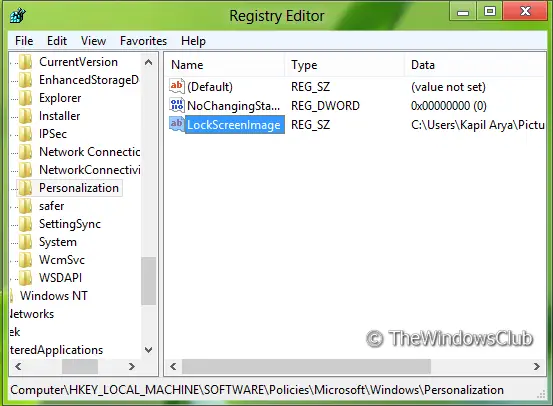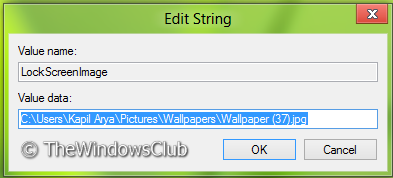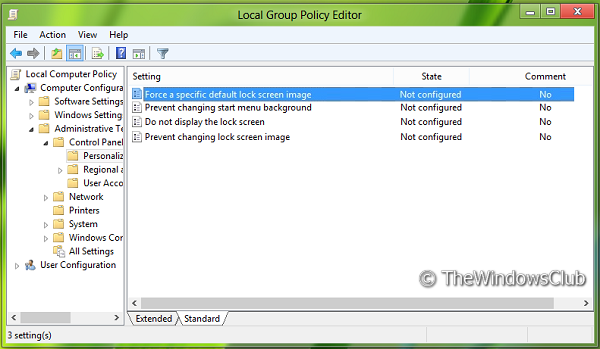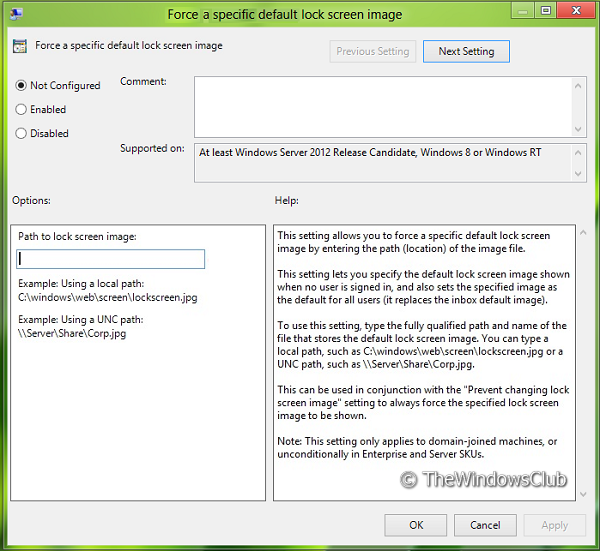By default, Microsoft allows its users to change the Lock Screen, but on a multi-user PC, you can prevent users from changing the lock screen or start screen background image using the Registry and Group Policy Editor.

Prevent users from changing Lock Screen in Windows 11/10
In this article, I’ll tell you how you can set a constant image for Lock Screen so that others cannot modify it.
NOTE: These settings will work only in Windows 11/10 Enterprise, Windows 11/10, and Windows Server Editions.
Using Registry Editor
1. Press the Windows Key + R simultaneously and put regedit in the Run dialog box.
2. Navigate to the following registry key:
HKEY_LOCAL_MACHINE\SOFTWARE\Policies\Microsoft\Windows\Personalization

3. In the right pane of this location, create a string named as LockScreenImage if it is not there. Now double-click on it, and put the location of your desired lock screen image as its Value data.

4. That’s it! Close the Registry Editor and reboot to get results.
Using Group Policy Editor
NOTE : This option for using group policy is only available in the Windows 11/10 Pro and Windows 11/10 Enterprise editions.
1. Press the Windows Key + R combination and put gpedit.msc in Run dialog box.
2. In the left pane navigate to:
Computer Configuration > Administrative Templates > Control Panel -> Personalization

3. Now look in the right pane, you’ll got the policy named Force a specific default lock screen image as shown above.
4. Double-click on this policy to get the window shown below.

5. Now you can use the following settings:
- Allow Lock Screen Background Change = Disabled/Not configured (Default Setting)
- Disable Lock Screen Background Change = Enabled
If you choose Enabled, specify the image path without quotes in the box show in the window.
This setting allows you to force a specific default lock screen image by entering the path (location) of the image file. This setting lets you specify the default lock screen image shown when no user is signed in, and also sets the specified image as the default for all users (it replaces the inbox default image).
After making changes click Apply followed by OK.
Here you will also see Prevent changing lock screen image setting. Enable it.
This setting prevents users from changing the background image shown when the machine is locked. By default, users can change the background image shown when the machine is locked. If you enable this setting, the user will not be able to change their lock screen image, and they will instead see the default image
When Force a specific default lock screen image is used in conjunction with the Prevent changing lock screen image setting, you can always force the specified lock screen image to be shown.
Read: How to disable the lock screen in Windows.
Prevent users from changing Start Screen in Windows 8.1/8
In the same Group Policy path, you will see another setting Prevent changing Start Menu background. Enable this setting to prevent users from changing the Start Screen background in Windows 8.
This setting prevents users from changing the look of their start menu background, such as its color or accent. By default, users can change the look of their start menu background, such as its color or accent. If you enable this setting, the user will be assigned the default start menu background and colors and will not be allowed to change them.
To disable changing the Start Screen background, in the same Registry path as shown above, create a new D-WORD (32-bit) value. name it NoChangingStartMenuBackground and give it a value of 1.
Reboot to see the results.
See this post if Windows Lock Screen grayed out or blacked out.
How do you stop people from changing your Windows 11 desktop wallpaper?
To stop people from changing your wallpaper, you need to open Group Policy Editor, go to User Configuration > Administrative Templates > Control Panel > Personalization, and double-click on Prevent changing desktop background. Set this policy to Enabled.
Also Read: Set desktop wallpaper using Group Policy or Registry Editor.
This is handy. You can’t change the lockscreen in a guest account and sometimes the guest default lockscreen would show instead of the personalized settings in the main account.
Hellow Kapil the option “Force a specific default lock screen image ” is not listed in local group policy editor. What should I do?
personalisation is not seen in my regedit means that sub division total personailisation is not availabe i can see system safer and all tha but the perso is missing what should i do
^^ The key should be there, however if it is not there, run the SFC /SCANNOW command in administrative Command Prompt and see if it adds the key. Otherwise add the key manually.